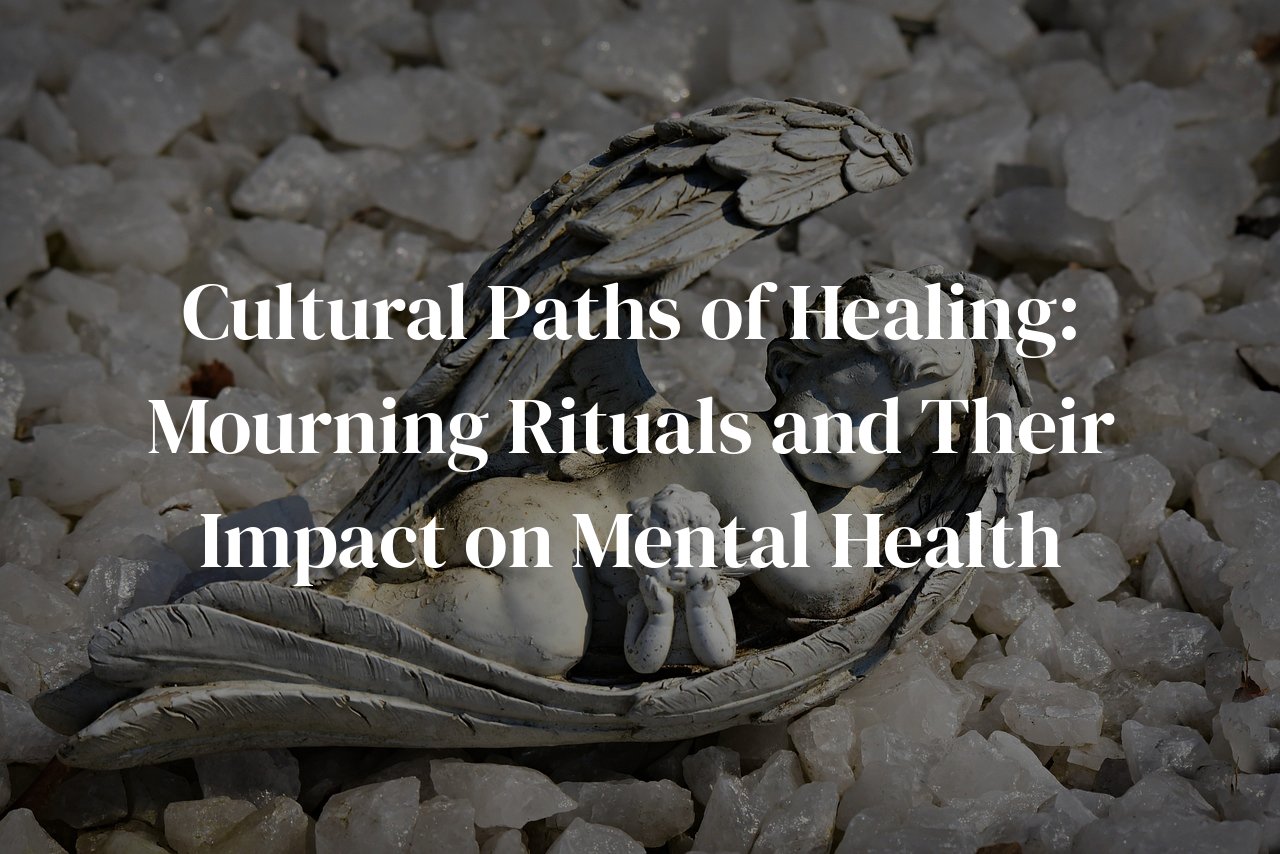
Exploring the diverse ways cultures mourn provides not only an eye-opening look into human tradition but also reveals critical insights into mental health.
In this post, we will delve into the vibrant tapestry of mourning rituals across cultures and examine how these practices influence mental well-being. By understanding these connections, you can gain invaluable perspectives on mental health that may even guide you in your own life or in supporting others through grief.
Table of Contents
Mourning Rituals Around the World
Embarking on a cross-cultural examination of mourning rituals reveals the profound diversity and deep-rooted traditions that shape how communities grieve and honor their departed. Traveling the world, both physically and through stories, has provided me a kaleidoscopic view of these customs, each illustrating a unique interplay between grief, culture, and mental health.
In Mexico, el Día de los Muertos: Let’s start with Mexico’s Día de los Muertos, or the Day of the Dead. This vibrant, multi-day celebration exemplifies the coexistence of mourning and festivity. Families create altars adorned with marigolds, sugar skulls, and favorite foods of the deceased, believing that the spirits return to partake. While the festival bears an air of festivity, it serves a profound purpose in uniting the living and the dead, fostering a sense of continuity and easing the painful pangs of loss.
Japan’s O-Bon: Moving eastward, Japan’s O-Bon festival resonates deeply with meditative tranquility. O-Bon, a Buddhist tradition, involves lighting lanterns to guide spirits back to the world of the living. Families gather, often visiting ancestral graves and dancing in Bon-Odori performances. This serene, reflective time emphasizes reverence and collective remembrance, lending a soothing, spiritual balm to the grieving hearts.
United States and Funeral Practices: In the United States, traditional funerary practices often revolve around solemn ceremonies that bring together family and community in remembrance. These ceremonies, whether religious or secular, offer structured environments for expressing sorrow and celebrating the deceased’s life. Despite the solemnity, these rituals are critical in helping mourners articulate their grief and begin the healing journey.
Ghanaian Fantasy Coffins: In Ghana, the Ga people have garnered attention for their creative and elaborate funerary practices, particularly their use of ‘fantasy coffins.’ These coffins are tailored to reflect significant aspects of the deceased’s life, such as their occupation or personal interests. This personalization transforms mourning into a celebration of individuality, offering an emotionally lighter, yet profoundly respectful approach to loss.
China’s Qingming Festival: Known as Tomb-Sweeping Day, China’s Qingming Festival involves visiting ancestral tombs, cleaning gravesites, and making offerings of food and joss paper. This ritual acts as a conduit between generations, maintaining a living relationship with the deceased and embedding grief within a broader, familial context.
From personal experience, engaging with these diverse mourning rituals has provided me a deeper understanding of the universal yet varied ways humans cope with loss. The rituals, whether grand or minimalistic, illuminate a shared need for connection, continuity, and emotional release, profoundly impacting mental health in ways that transcend geographic boundaries.
The Psychological Benefits of Mourning Practices
[‘
Mourning rituals serve as vital processes for individuals coping with loss, enabling a structured way to experience and express grief. These practices provide psychological benefits that can help facilitate emotional healing and mental well-being.
‘, ‘
One significant benefit is the sense of community and support. Participating in communal mourning rituals offers a platform for collective grieving, which validates individual emotions and makes the bereaved feel less isolated. During these rituals, shared experiences and empathy can provide immense comfort.
‘, ‘
Engaging in mourning practices also allows for emotional expression. Societal norms often pressure individuals to suppress their emotions, but mourning rituals create a safe space to express grief openly. This expression is crucial for mental health, as it helps prevent the internalization of unresolved emotions, which can lead to long-term psychological issues.
‘, ‘
Another advantage of mourning customs is the opportunity for emotional release. When individuals feel free to cry, share memories, or partake in meaningful ceremonies, they can release pent-up emotions. This emotional catharsis can significantly alleviate the intensity of grief and promote psychological relief.
‘, ‘
Mourning practices often include symbolic acts that provide a sense of closure. Rituals such as lighting candles, offering flowers, or saying final goodbyes enable a tangible way to commemorate the deceased. This process helps the bereaved transition from denial to acceptance, which is a pivotal step in the grieving journey.
‘, ‘
Furthermore, I have personally found solace in participating in mourning rituals. After losing a loved one, attending a memorial service allowed me to publicly honor their memory and share my pain with others who felt the same loss. This shared experience of mourning brought a profound sense of relief and connection.
‘, ‘
Mourning rituals also integrate elements of mindfulness and reflection. By engaging in specific practices, individuals are prompted to reflect on their relationship with the deceased and the meaning of their loss. This introspection fosters a deeper understanding of their grief, aiding the healing process.
‘, “
In sum, the psychological benefits of mourning practices are multifaceted, providing emotional support, expression, release, closure, and introspection. These rituals are not merely cultural traditions but essential mechanisms for maintaining mental health during one of life’s most challenging experiences.
“]
Comparative Analysis: East vs. West
The mourning rituals in Eastern and Western cultures, though centered around the universal experience of loss, manifest in profoundly different ways, offering unique perspectives on grief and healing. Having traversed both cultural landscapes, I’ve observed how these diverse practices shape mental health and community resilience.
In many Eastern cultures, communal grieving is pivotal. For instance, in Japan, the practices surrounding Obon season involve families returning to ancestral homes and participating in rituals to honor deceased spirits. These ceremonies not only revere the dead but also strengthen familial bonds and provide collective solace. The Buddhist tradition emphasizes continuity and the cyclical nature of life and death, which can be profoundly soothing, offering a philosophical framework for understanding loss.
Conversely, Western mourning rituals often emphasize personal grief over communal participation. In countries like the United States, the focus tends to be on individual emotional processing, supported by professional therapy and counseling. Funerals in the West, while sometimes community events, often prioritize the immediate family and close friends, promoting a more private expression of sorrow. This approach aligns with Western values of independence and self-reliance but may sometimes leave individuals feeling isolated in their grief.
Moreover, the symbolic expressions of grief differ markedly. In many Eastern cultures, tangible symbols such as altars, offerings, and seasonal festivals maintain ongoing connections with the deceased. The Qingming Festival in China is an excellent example, where families sweep tombs and make offerings. These practices perpetuate a sense of continuity and can be immensely comforting. In contrast, Western traditions might involve memorial services and the preservation of personal mementos, like photographs. While these too honor the deceased, they often serve as static reminders rather than active engagements with the past.
Another significant distinction is in the duration and societal expectations of mourning. In many Eastern societies, mourning periods are often longer and more explicitly defined. In Hindu tradition, for example, there is a series of rituals spread over 13 days, and sometimes up to a year, each stage designed to guide the soul and provide structured support for the bereaved. In contrast, Western cultures may have more abbreviated mourning practices, with the primary rites concluding within days or weeks. This difference reflects contrasting temporal perceptions of grief and communal responsibilities in aiding mental recovery.
Reflecting on my personal experience, attending a traditional Japanese family memorial and later, a Western funeral, highlighted the stark contrasts. The shared meals, the meticulous care in honoring ancestors in Japan fostered a profound sense of community and continuity that I found deeply reassuring. Meanwhile, the Western service provided a more introspective space, offering moments for personal reflection and emotional catharsis. Each approach, in its own way, holds valuable lessons on navigating the complex journey of bereavement.
Modern Adaptations of Ancient Mourning Rituals
In an increasingly connected world, traditional mourning rituals have evolved and adapted to fit modern lifestyles and sensibilities. One compelling adaptation is the digital memorial. Family and friends now create online spaces to share memories, photos, and messages, creating a virtual space for collective grieving. From Facebook memorial pages to specialized websites like ‘Forever Missed,’ these online platforms offer the opportunity for global participation in the mourning process.
Another adaptation is eco-friendly burials. Contemporary society is becoming more environmentally conscious, and this is reflected in the way we approach death. Ancient rituals often involved elaborate tombs or burial mounds, but today’s green burials aim to return the body to the earth in a natural and sustainable way. This practice not only honors traditional earth-centric beliefs but also contributes to the conservation of natural habitats.
Yoga and meditation, rooted in ancient Indian practices, have also found their way into modern mourning rituals. These activities offer a means to cope with grief and maintain mental health through focused breathing and mindfulness. While they might not replace a cultural or religious ceremony, they complement it by addressing the need for individual emotional release.
Art therapy is another example of an ancient ritual reborn for the modern age. Historical mourning customs often included artistic expressions such as weaving shrouds or creating intricate grave markers. Today, therapists use art activities to help individuals process grief, allowing them to express their emotions in a tangible form. Drawing, painting, or crafting can serve as a therapeutic outlet, channeling sorrow into creativity.
Interestingly, public mourning ceremonies have also taken on new forms. In the past, community gatherings might involve long processions or days of collective mourning. Today, with advanced communication and travel, these gatherings can happen more fluidly and might include multicultural elements. For instance, someone could incorporate a traditional Irish wake with elements of a New Orleans jazz funeral, blending rituals to suit personal or family preferences.
From my personal experience, when my grandmother passed away, our family decided to incorporate some of these modern adaptations into our mourning process. We held an online memorial service allowing relatives from across the globe to participate. Surprisingly, I found solace in creating a small garden in her memory, combining the modern eco-friendly approach with my grandmother’s love for nature. This blend of old and new not only provided emotional relief but also helped us honor her memory in a way that felt profoundly meaningful.
As we navigate the complexities of modern life, these adaptations of ancient mourning rituals offer a bridge between time-honored traditions and contemporary needs. They serve as a testament to the human ability to innovate while respecting the past, ensuring that the spiritual and psychological benefits of mourning rituals remain accessible across generations.
Personal Reflections on Mourning and Mental Health
Mourning is an emotionally complex journey that touches every aspect of one’s life. During the loss of my grandmother, I found solace in the rituals and ceremonies that our family carried out. As a child, I always thought these were just old-fashioned practices, but in my adult years, I see them as a profound coping mechanism that provided emotional healing. The act of gathering together for her memorial brought an unexpected comfort that words alone could not provide.
In the West, where I now reside, mourning can sometimes feel like an isolated experience. Here, I noticed that people often grieve in private, negotiating their feelings in solitude. This can leave one feeling alone, prolonging the process of emotional recovery. However, during my travels to Eastern cultures, I observed that mourning is a community affair. In Japan, memorial services can stretch out over a 49-day period where family members and the community come together to share memories and provide emotional support. The ritualistic aspect of grief serves as a bridge, connecting the past, present, and future, making the loss somehow bearable.
Modern adaptations of these age-old practices have also caught my attention. Digital memorials and virtual ceremonies have emerged as contemporary methods to honor those who have passed away. I participated in an online memorial for a friend last year, which allowed people from across the globe to share their condolences and memories. Initially, I was skeptical about its effectiveness, but I was deeply moved by the stories shared, realizing that the essence of mourning rituals remained intact even when adapted to a digital platform.
Despite the differences in cultural approaches to mourning, I have come to understand that these rituals serve a critical psychological function. They offer a structured way to process grief and remind us that we are not alone in our sorrow. They give us permission to grieve openly and set the stage for emotional healing. Participating in these mourning practices, whether traditional or modern, has helped me navigate through my own periods of loss, proving that while the methods may vary, the benefits of communal grieving are universal.
Conclusion
Understanding the profound connection between cultural mourning rituals and mental health can transform our approach to grief. By acknowledging and respecting different practices, we foster a more empathetic and supportive environment for all.
May these insights serve as a beacon, guiding you through the complex maze of mourning and mental well-being.



